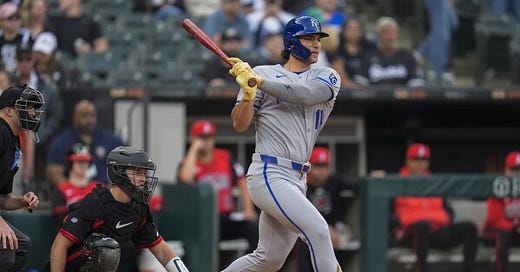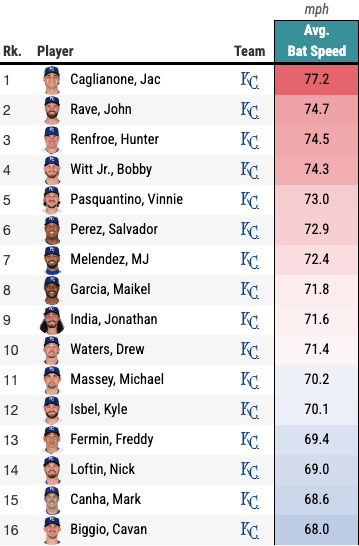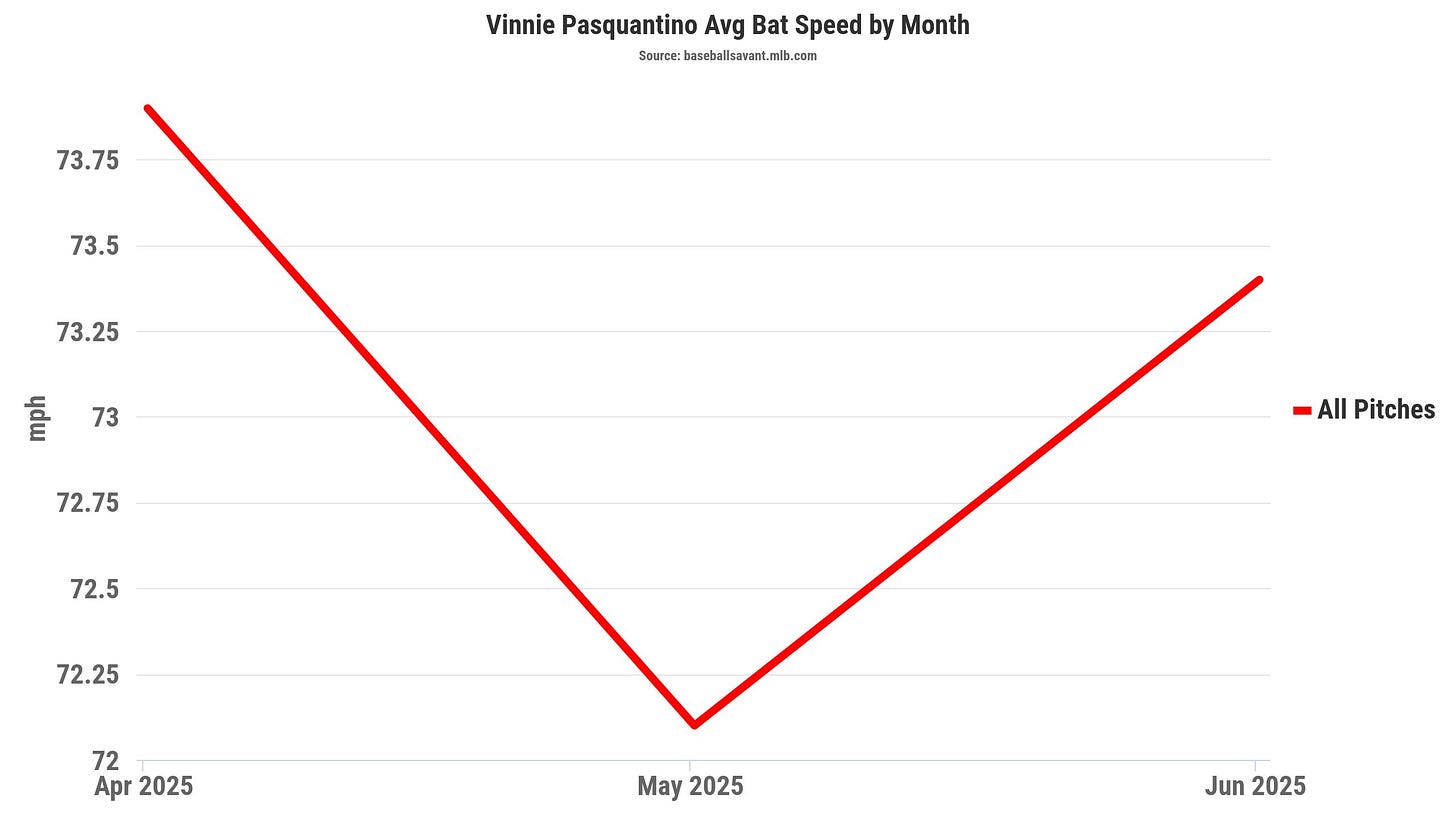Saturday Study Hall is a biweekly series defining advanced stats, data and analytics to investigate how they impact the Royals.
The anticipation for Jac Caglianone’s debut was rare in the annals of Royals history. Recency bias so often clouds our judgment with these things, as it wasn’t so long ago Bobby Witt Jr. stood in front of an Opening Day crowd in 2022 to step into the box for his first at-bat in Royal Blue.
More than a decade ago — has it really been that long? — Kansas City enjoyed a parade of prospects ascending to the Major Leagues, including Eric Hosmer, Mike Moustakas, Danny Duffy and Salvador Perez in 2011, franchise stalwarts who’d eventually lead the club to an actual parade.
But special circumstances surrounded Caglianone’s debut in St. Louis. For one, this team is actually in contention with immediate playoff aspirations rather than future dreams. Secondly… he’s just a different type of player than the Royals have developed in the past, carrying prodigious power that sets him apart even from Moustakas (who belted 36 minor league homers in 2010) and others before him.
Royals Data Dugout requires a paid subscription for some (not all!) posts. Saturday Study Hall is free for all, but you can take advantage of a discount on an annual subscription at the link below until Monday, June 16.
Upgrading to a paid subscription means access to all newsletters, the ability to comment on posts and access to subscriber chat while supporting everything I’m working on here at Royals Data Dugout.
One of Caglianone’s key traits, meshing perfectly with his tight end-esque size, is his bat speed. Among 469 Major Leaguers who’ve taken 50 or more competitive swings this season, his 77.2 MPH average bat speed is seventh-highest, on par with the game’s swing speed savants like Oneil Cruz, Junior Caminero, Aaron Judge and Kyle Schwarber.
At a foundational level, “bat speed” defines itself: How fast does a hitter, on average or on a singular swing, move the bat through the zone.
Here’s a bit more detail from Baseball Savant:
Since different parts of a bat can move at different speeds, an individual swing’s speed is measured at the point six inches from the head of the bat, what is popularly called “the sweet-spot.”
So that quickly sums up the definition portion of the program. But how much does bat speed matter?
Similar to our prior experiment with exit velocities, let’s break it up into bands and show how faster (and slower) swing speeds impact tangible results.
2025 MLB Averages
For a thorough examination, let’s include surface stats like batting average and slugging percentage; batted-ball metrics like average exit velocity and hard-hit rate; and whiff rate to see if there’s any drawback to faster swings. (Statistics as of Thursday, June 12.)
60-65 MPH bat speed (12,762 swings): .205 BA, .237 SLG, 80.4 MPH EV, 9.9% HH, 23.4% Whiff
65-70 MPH bat speed (34,417 swings): .223 BA, .297 SLG, 86.2 MPH EV, 30% HH, 23.4% Whiff
70-75 MPH bat speed (50,404 swings): .266 BA, .436 SLG, 90.7 MPH EV, 45.3% HH, 24.3% Whiff
75-80 MPH bat speed (24,740 swings): .310 BA, .607 SLG, 94.1 MPH EV, 55% HH, 25.2% Whiff
80-85 MPH bat speed (3,901 swings): .328 BA, .700 SLG, 94.8 MPH EV, 56.8% HH, 19.5% Whiff
85+ MPH bat speed (428 swings): .349 BA, .750 SLG, 93.9 MPH EV, 56.5% HH, 13.3% Whiff
Clear trend lines indicate yes, bat speed does matter, as you may have expected. Another interesting note here is the whiff rate: It doesn’t increase with faster bat speeds the way you (and I) might naturally believe.
“He’s swinging too hard” is sort of a misnomer, based on the data.
Running parallel with that train of thought, whiff rates sharply falling to 19.5% in the 80-85 MPH bucket and 13.3% in the 85+ MPH bucket is a bit surprising. The only rational explanation I have is twofold: Only the best players in baseball can reach those swing speeds, and those swing speeds are likely coming more often on center-cut pitches when a hitter lets it rip — but that’s purely speculation on my part.
2025 Royals Bat Speeds
Lo and behold, the Royals are a prime example that bat speed matters, but it’s not everything. Maikel Garcia is right in line with the 71.7 MPH league average swing speed, yet he’s enjoying the best campaign of his career and making a bid for the All-Star Game.
John Rave and Hunter Renfroe, one of whom is on thin ice on the 26-man roster and the other of whom has already slipped into the sea, rank second and third in average bat speed, both well above the league median.
The more interesting conversation pertains to Vinnie Pasquantino, whose healthy offseason led to a jump from last year’s 71.7 MPH bat speed (again, league-average) to 73 MPH in 2025. He got off to a slow start but, since May 1, he’s slashing .355/.402/.500 with six long balls.
Pasquantino’s bat speed tailed from 73.9 MPH in April to 72.1 MPH in May, but has rebounded to 73.4 MPH in June. I don’t believe the slower bat speed led to better results, to be clear, but it’s noteworthy for a player who spoke publicly about the swing speed jump leading him to be in front of a lot of pitches early in the season.
Royals Data Dugout Updates
Just two days left to capitalize on the annual subscription discount! Take it from Stanton and Rolland, two of the earliest to upgrade to paid subscriptions.
Your support is appreciated as I continue to build the publication, with plenty of exciting stories, collaborations and data dives ahead.
On tap for Tuesday — for paid subscribers — is an exploration of Caglianone’s first two weeks in the Major Leagues, where I’ll analyze his batted-ball data, swing decisions and rest-of-season projections.










